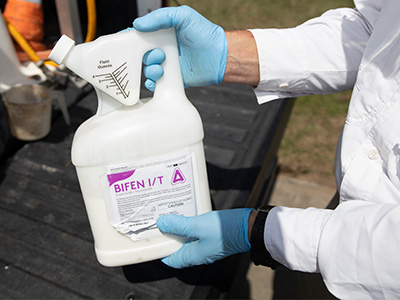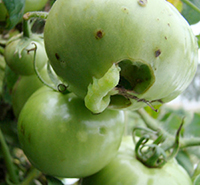The Basics of Pesticides

What are pesticides?
Simply put, pesticides are chemicals that are used to manage pests. It’s important to understand that the term “pesticide” is a broad term that can be used to describe a number of specific chemicals, including herbicides and insecticides, just to name two. All pesticides will have a registration number on the label that has been issued by the U.S. Environmental Protection Agency and that certifies that the pesticide has been tested and approved for use.
Since pests can come in many forms, there are different classes of pesticides available on the market:
- Herbicides—plants, including weeds
- Insecticides—insects (includes biorational insecticides like oils, soaps, and microbials)
- Bactericides—bacteria
- Fungicides—fungi
- Miticides—mites
- Rodenticide—rats and mice
Why do we use pesticides?

Ever since pesticides have been available, society has been concerned with potential risks associated with their use. Most people would acknowledge that the benefits of pesticides in today’s society outweigh the risks associated with their use, especially when the risks are identified and kept under control.
For example, using pesticides to control mosquito populations can help prevent the spread of mosquito-borne diseases like West Nile virus, Eastern equine encephalitis, and malaria. When pesticides are used responsibly, they can help us in many ways:
- Protect our health and the health of our pets
- Prevent pest damage to food crops
- Improve landscapes and waterways
- Maintain roadside right-of-ways
- Keep spaces clean
However, using pesticides shouldn’t be the default response to seeing pests. In instances when only a few are present, it is better to try other methods of pest control. For example, if a lone dandelion pops up in the lawn, the most appropriate response is to pull it by hand. Or if you find a few hornworm caterpillars on a tomato plant, the first option should be to hand pick them. If insect pests swell to levels where hand removal is no longer feasible, then it is appropriate to consider using pesticides. Learn more about Integrated Pest Management.

It’s best to start with the least toxic products first. These are often known as biorational pesticides and include horticultural oil and insecticidal soap sprays, plant-derived insecticides like neem oil and pyrethrum, and microbial pesticides like Bt.
Biorational insecticides are typically used to target soft-bodied pests like caterpillars or aphids. They provide a relatively non-toxic alternative to conventional insecticides, often with few ecological side effects. Timing is important, and you may need to repeat applications to get the best results. Check the product label for more information. By choosing to use biorational insecticides instead of conventional insecticides, you’ll be able to manage pests with minimal effect on beneficial insects.
Horticultural soaps can be used on pests like aphids, mealybugs, whiteflies, and spider mites. They can be used on indoor and outdoor plants, including vegetables. You can find homemade recipes on the Internet, but the results from commercially available sprays are more predictable. Be sure to follow the label instructions. For example, spraying on a hot day may cause damage to the plant. Horticultural soaps only work when they come in direct contact with pests.
Even if pest populations are large, more toxic pesticides may not be the most appropriate choice. For example, if an insect population expands near the end of summer, the pending changes in temperature and day length may be enough to bring the populations back under control.
Before using pesticides, get to the source of the problem. By knowing what’s causing the problem, you can respond appropriately. For example, you wouldn’t want to spray a plant with an insecticide if it’s actually suffering from a fungal disease. Pest identification is the critical step in determining the right pesticide to use.
Once gardeners identify the pest, they can visit a garden center and consult the labels on various products to see if the pest is listed in the “pests controlled” section. By using pesticides responsibly, gardeners can help minimize effects on beneficial insects like honey bees and protect the environment as a whole.
Also on Gardening Solutions
- Biopesticides: Bt and Spinosad
- Biopesticides: Horticultural Oils
- Integrated Pest Management (IPM)
- Pesticide and Fertilizer Disposal
- Pesticide Application
- Pesticide Labels
- Pesticide Types
- Soaps, Detergents, and Pest Management
